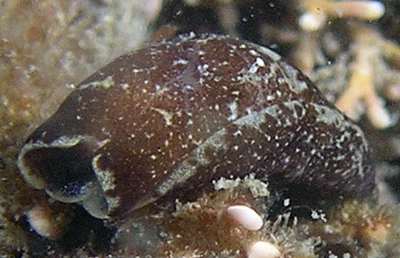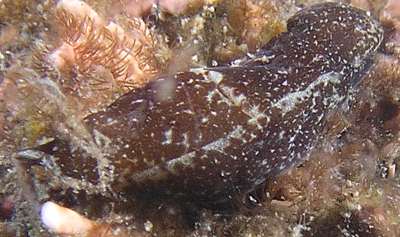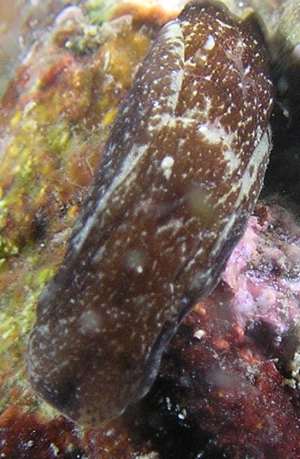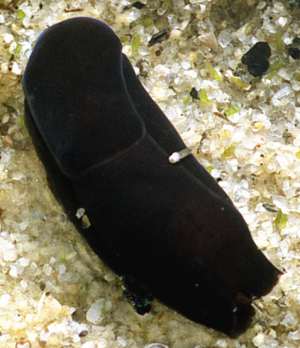Melanochlamys diomedea
(Bergh, 1894)
Order: CEPHALASPIDEA
Superfamily: PHILINOIDEA
Family: Aglajidae
DISTRIBUTION
West coast of Nth America [Alaska to California]
Translucent body with a mottling of black or dark brown which varies between individuals some being almost black in appearance. Lives on mud and other soft sediments from intertidal to 370ft [Behrens, 1991]. Feeds on worms and grows to about 15 mm long.
-
Bergh, L.S.R. (1894) Die Opisthobranchien. Reports on the dredging operations off the west coast of Central America to the Galapagos, to the west coast of Mexico, and in the Gulf of California, in charge of Alexander Agassiz, carried on by the U. S. Fish Commission steamer Albatross, during 1891, Lieut. Commander Z. L. Tanner, U.S.N. commanding. Part 13. Bulletin of the Museum of Comparative Zoology, Harvard, 32(10): 125-233.
-
Rudman, W.B. (1972) On Melanochlamys Cheeseman, 1881, a genus of the Aglajidae (Opisthobranchia: Gastropoda). Pacific Science, 26(1): 50-62, 8 figs.
-
Steinberg, J.E. & Jones, M. (1960) A new opisthobranch of the genus Aglaja in San Francisco Bay. The Veliger, 2: 73-75.
Rudman, W.B., 2003 (April 5) Melanochlamys diomedea (Bergh, 1894). [In] Sea Slug Forum. Australian Museum, Sydney. Available from http://www.seaslugforum.net/find/meladiom
Related messages
Melanochlamys diomedea? from Sth Korea
May 23, 2005
From: Dong Bum Koh


Dear Bill,
Here are some photos of what is perhaps a juvenile form of Philinopsis gigliolii. But I'm not sure. Please let me know about this animal?
Locality: Sung San Beach. Jeju. Sth Korea. Depth: 8 m.Length: 20 mm. 19 May 2005. Rocky bottom. Photographer: Sang Yul Shin
Best regards,
Dong Bum Koh
drkoh@seasee.co.kr
D.B. Koh, 2005 (May 23) Melanochlamys diomedea? from Sth Korea. [Message in] Sea Slug Forum. Australian Museum, Sydney. Available from http://www.seaslugforum.net/find/13847
Dear Koh,
This is quite interesting. I am pretty sure this is a species of Melanochlamys. If it were Philinopsis then there would be a distinct pointed median 'crest' on the posterior border of the head shield. I would also expect the the posterior funnel at the posterior end of the body to be large and more flared.
Sang Yul Shin's photos look very like Baba's drawing of Melanochlamys ezoensis from northern Japan. In recent messages [#13670, #13694] we have examples of a black form of Melanochlamys from the north-west part of Sea of Japan, which Russian workers consider merges into a less pigmented from like yours, which they consider is Melanochlamys diomedea.
I suspect your animal is a mottled form of Melanochlamys diomedea. If so, this find extends it distribution a long way down the north western Pacific. If anyone has photos of Nth American examples of M diomedea to share with us, I would be very grateful.
Best wishes,
Bill Rudman
Melanochlamys diomedea from E. Russia
May 2, 2005
From: A.V. Chernyshev, E.M. Chaban, A.V.Ratnikov

Dear Bill,
Melanochlamys diomedea is one of two aglajid species in north-west part of Sea of Japan. The second species is Philinopsis gigliolii. M. diomedea is common in the Japan Sea from Peter the Great Bay to Tatar Strait and South Sakhalin. It lives in sand at depths 0-80 m (Chaban, Martynov, 1998). The body is a black mottling, but the some specimens show very dark uniform coloration (Photo by A. Ratnikov)
Locality: Peter the Great Bay, Russia, Sea of Japan, Pacific Ocean. Depth: 8 m. Length: 9 mm. August 2003. sand. Photographer: A.V. Ratnikov.
-
Chaban E., M., Martynov A. V. (1998) Melanochlamys diomedea (Bergh, 1893) (Opisthobranchia: Aglajidae), a new genus and species in the fauna of Russia. Ruthenica, 8(2): 147-152 (in Russian).
Best wishes,
Alexei V. Chernyshev, Elena M.Chaban & Alexander V. Ratnikov
tsher@bio.dvgu.ru
Chernyshev, A.V., Chaban, E. M., & Ratnikov, A.V., 2005 (May 2) Melanochlamys diomedea from E. Russia. [Message in] Sea Slug Forum. Australian Museum, Sydney. Available from http://www.seaslugforum.net/find/13670Dear Alexei, Elena & Alexander,
This is another interesting range extension. It would be nice to get some photos from the Nth American coast. Have you any thoughts on Melanochlamys ezoensis which Baba described from northern Japan. Unfortunately I don't know anything about it except its external appearance, but it seems to me it could just be a mottled form of M. diomedea.
Best wishes,
Bill Rudman
Re: Melanochlamys diomedea from E. Russia
May 2, 2005
From: Alexei Chernyshev
Dear Bill,
Concerning your query [#13670]:
Elena Chaban and Alexander Martynov (1998: 150-151) observed poorly pigmented specimens from South Kuril Strait and considered Aglaja ezoensis as a synonym of M. diomedea.
- Chaban E., M., Martynov A. V. (1998) Melanochlamys diomedea (Bergh, 1893) (Opisthobranchia: Aglajidae), a new genus and species in the fauna of Russia. Ruthenica, 8(2): 147-152 (in Russian).
With best wishes,
Alexei
tsher@bio.dvgu.ru
Chernyshev, A.V., 2005 (May 2) Re: Melanochlamys diomedea from E. Russia. [Message in] Sea Slug Forum. Australian Museum, Sydney. Available from http://www.seaslugforum.net/find/13694Thanks Alexei,
Bill Rudman
Puget Sound slug - Aglaja diomedea?
June 21, 2003
From: Eric Parker
Looking for information on Aglaja diomedea to confirm an ID. Found in Puget Sound on fairly desolate fine sandy bottom offshore of eelgrass margin. Very small, black, no visible shell but not ruling it out. Could this be Aglaja diomedea?
Eric Parker
researchsupport@earthlink.net
Dear Eric,
A photo is always a help, but black slugs are difficult to photograph. Have a look at the page on Melanochlamys cylindrica, which is a very similar looking species from New Zealand. Note that this species is placed in the genus Melanochlamys,not Aglaja, and most probably feeds on polychaete worms
Best wishes,
Bill Rudman
Re: Melanochlamys diomedea(?) in San Francisco Bay
April 9, 2003
From: Dave Behrens
Hi Bill:
Concerning Andrea's question. Yes, this species is common in all the bays and estuaries along the coast up into Canada and Alaska. This species is not often noticed in bottom samples as specimens are usually small and fairly undistinctive.
Dave Behrens
dave@seachallengers.com
Melanochlamys diomedea(?) in San Francisco Bay
April 7, 2003
From: Andrea Swensrud
Dear Bill,
In the past six months, we have pulled up two slugs that I am unfamiliar with in our trawls in the South San Francisco Bay. I don't have any pictures, but they fit the description of Melanochlamys diomedea in Pacific Coast Nudibranchs by David Behrens. They have been found on muddy bottoms at a depth of approximately 15-20 feet, and are about 15mm. Do you know if this species is found in the San Francisco Bay?
Andrea Swensrud
Marine Science Institute
andrea@sfbaymsi.org
Dear Anne,
I am not an expert on the San Francisco fauna, but Melanochlamys diomedea is found along most of the west coast of North America. If it looks like the animal in Dave's photo then chances are that's what it is.
Best wishes,
Bill Rudman
